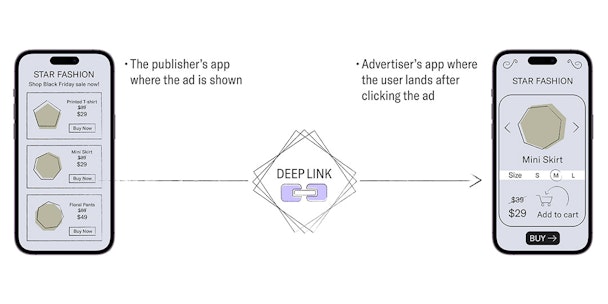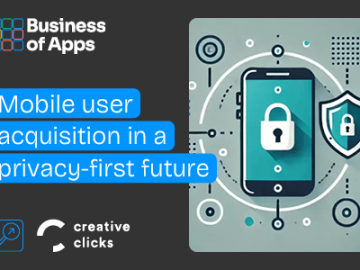Explore the role of deep links in mobile advertising and discover best practices to boost app engagement and revenue.
Many businesses rely on their mobile apps as a means of engaging and converting customers. A survey by ContractIQ found that roughly 62% of businesses already have their own app, or are in the process of developing one. While apps can be a lucrative channel for driving sales and retention, it’s worth noting that some app-marketing strategies are more effective than others.
In this article, we examine the role and use of deep links in mobile advertising and discuss best practices to help you drive more revenue and engageme on mobile.
What are deep links?
Deep links are links that direct a user to a specific page or location within an app. The concept of deep linking originally came from the web, where URLs bypassed a website’s homepage and brought the user to more personalized and relevant subpages. As the use of mobile apps became more prevalent, marketers realized the need for similar mechanisms in the app ecosystem. This gave rise to deep links for mobile.
In an episode of Remerge’s Apptivate podcast, senior product marketing manager at Branch, Amanda Vandiver, described deep links as “creating that connection, that match, between the share-point and the person on the other end opening the app – making sure that they are taken to the right place.”
How do deep links work?
Deep links work through unique URIs (uniform resource identifiers) that point to specific locations within an app. When a user clicks on a deep link, it opens the app and directs them to the desired content or page within the application. However, the flow ultimately depends on whether the user already has the app installed on their device. With that in mind, there are three main types of deep links, each with their own functionalities:
Basic deep links
These links direct users to specific content within an app, but only work if the app is already installed on the user’s device.
Deferred deep links
These links first redirect users to the app store, if the app is not already installed on their device. After the install is complete, the user is then automatically taken to the intended location within the app.
Contextual deep links
These are much like basic deep links, only they provide advertisers with more information about the source of the click. They can also contain data about the user and they possess functionalities such as the automatic application of discount codes when a user clicks an ad to claim a discount.
The user’s mobile operating system should be taken into account when using deep links. On iOS specifically, advertisers can use Apple Universal Links which enable users to avoid a privacy-related Apple pop up that requests user permission to open an app on their device. A non-Apple deep link would trigger this pop up and negatively impact the user journey. At Remerge, we found that one of our clients saw a 250% increase in re-engagement rates once we implemented Apple Universal Links into their iOS retargeting campaigns.
Google also has its own Android-specific mechanism for deep linking called ‘App Link’. However, for app businesses who want to run in-app retargeting campaigns on both iOS and Android, some MMPs (mobile measurement partners) can help you create deep links that will work on both types of mobile operating systems. Your MMP will provide you with these multi-functional deep links so that your DSP (demand side partner), such as Remerge, can implement them into your campaigns.

5 ways deep links help you achieve your advertising KPIs
1. Simplified user journeys
Deep links significantly improve the user’s journey through your app. When a user clicks on an ad, the deep link automatically opens your app and takes the user directly to a specific page that corresponds with the offer or content that was displayed in the ad. Without a deep link, a user would have to open your app, then manually navigate to the relevant page, which means they are more likely to get distracted instead of completing the intended goal of the ad. For this reason, using deep links is a key way to reduce friction in the user journey.
2. Higher conversion rates
By simplifying the user journey from the ad click to the delivery of content, you increase your likelihood of conversions. This is especially crucial in mobile advertising, where user attention spans are short. While running in-app retargeting campaigns, our team at Remerge found that when one of our clients began using Universal Links (the Apple-specific deep link), the re-engagement rate of their campaigns immediately increased by 500%.
3. Hyper-personalized marketing
Deep links, or more specifically, contextual deep links, enable advertisers to further personalize their marketing campaigns. Marketers can take data about the user and where they originally clicked the link – then use it to dynamically tailor the in-app experience. Personalized user experiences lead to better retention and overall engagement.
4. Improved retargeting
Deep links can be used in retargeting campaigns to bring users back to specific app pages that they have previously shown an interest in. This is particularly useful for ecommerce brands as they can retarget existing users who have viewed or added items to their in-app shopping cart, but not completed the checkout process. Retargeting these users with personalized ads that lead them directly back to the checkout page with a single click helps to drive revenue and boost lifetime value (LTV).
5. Analytics and insights
Deep links offer advertisers robust analytics and insights by directly connecting users to specific in-app content, allowing for precise tracking of user engagement and behavior. Advertisers can gather data on how users interact with different campaigns, find out what content drives conversions, and learn which links and creatives are most frequently clicked. This granularity enables the measurement from the initial interaction to the final action, providing insights into user preferences.
Deep links also facilitate A/B testing which can help app businesses to refine their targeting and personalization efforts, while also helping them to improve the user experience.

How do you set up a deep link?
As described in this guide, the short answer is that you’ll need to define the content or page within the app that you want to link to and create a unique URL or URI that points to that location within the app. You’ll then need to add the deep link to your app’s codebase, either using a third-party tool or by implementing it directly. The exact process for creating a deep link will depend on the programming language and framework you are using for your app and the type of mobile operating system where your deep links will be used.
For personalized guidance and deep linking best practices, consult a trusted DSP like Remerge and your MMP who can advise you on the technical setup you’ll need to begin testing and using deep links for your in-app advertising campaigns.

Executive summary
Deep links are essential for optimizing your app marketing efforts. They help to streamline the user’s journey through your app and they reduce friction, which leads to better engagement and conversion rates. They also facilitate hyper-personalized campaigns for both user acquisition (UA) and retargeting. Not only that, but deep links provide robust analytics and allow advertisers to track user behavior, which helps greatly with campaign optimization.
For successful deployment of deep links, working with MMPs and Demand DSPs is crucial, as they provide the necessary technical expertise and can support with implementation.
For more information about deep linking and in-app retargeting, get in touch with Remerge today.




